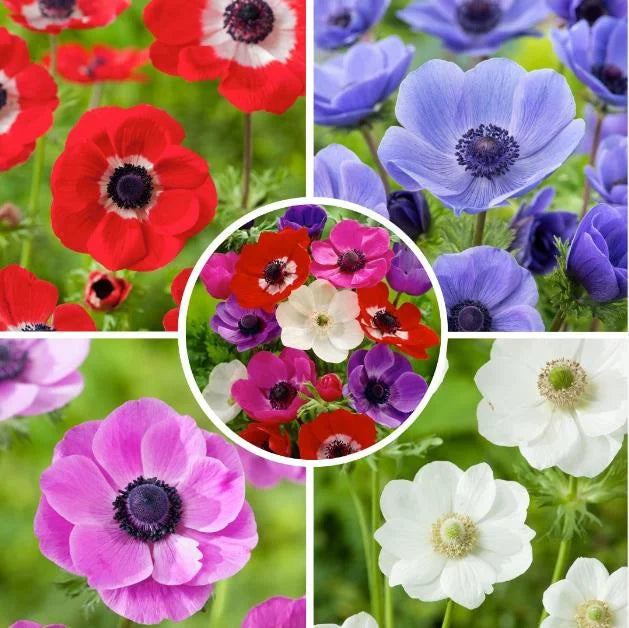Anemone Seeds
Couldn't load pickup availability
Description
Anemone flowers, often referred to as windflowers, are prized for their vibrant, colorful blooms and their graceful, delicate appearance. These perennial plants produce anemone-shaped flowers in shades of red, white, pink, purple, and blue, each with a dark, contrasting center. Anemone flowers are suitable for a variety of garden styles, from cottage gardens to wildflower meadows and borders. Their lightweight, poppy-like blooms dance in the breeze, making them a favorite for creating natural, carefree garden spaces. Whether grown for their beauty in the garden or used in cut-flower arrangements, anemones are a charming and versatile choice for gardeners of all levels.
Key Features
- Flower Colors: Available in a range of vibrant colors, including red, white, pink, purple, and blue, often with a dark central eye.
- Plant Height: Typically grows 12–24 inches tall, making them suitable for garden borders, flower beds, or containers.
- Bloom Period: Blooms in late spring to early summer, depending on the variety, providing a burst of color at the start of the growing season.
- Growth Habit: Upright with a bushy, compact habit. The flowers appear on slender stems above the foliage.
- Hardiness: Suitable for USDA Zones 3–9, ideal for most temperate climates.
- Growth Rate: Moderate to fast-growing, with flowers appearing in the first year when started from seed under optimal conditions.
Why Choose Anemone Seeds
- Seasonal Color: Anemones offer early-to-mid-season blooms, brightening up your garden in spring and early summer with vibrant, long-lasting flowers.
- Low Maintenance: Once established, anemones are relatively easy to care for, requiring only minimal watering and occasional maintenance.
- Versatile in Landscaping: Perfect for planting in flower beds, borders, or naturalized meadows, anemones can be used to fill spaces between taller plants or as a ground cover.
- Attracts Pollinators: Anemones attract bees, butterflies, and other beneficial pollinators, making them a great addition to a wildlife-friendly garden.
- Cut Flower Potential: The long-lasting blooms make anemones excellent candidates for cut flower arrangements, adding a pop of color and elegance to indoor spaces.
How to Grow and Care for Anemone Seeds
- Planting Location: Anemones prefer well-drained soil with a slightly acidic to neutral pH. They thrive in full sun to partial shade. Full sun will encourage better blooming, while partial shade can help extend the flowering period in hotter climates.
-
Planting Instructions:
- Start seeds indoors 8–10 weeks before the last expected frost date or sow directly outdoors in early spring or fall.
- If starting indoors, sow seeds in a tray or pots filled with well-draining seed-starting mix. Press seeds gently into the soil and lightly cover them with a thin layer of soil.
- Keep the growing medium moist but not soggy. Maintain a temperature of 65–70°F (18–21°C) for optimal germination, which can take 10–21 days.
- Once seedlings are large enough to handle, transplant them into their permanent location in the garden.
- For direct sowing outdoors, scatter seeds on the surface of the soil and press them in lightly. Keep the soil moist until germination occurs.
- Watering: Water regularly to keep the soil evenly moist, but avoid waterlogging, as this can lead to root rot. Water the base of the plant and avoid getting the foliage wet to prevent fungal diseases.
- Fertilization: Anemones are relatively low-maintenance when it comes to fertilization. A balanced, slow-release fertilizer applied in early spring will support healthy growth. Avoid over-fertilizing, as this can lead to excess foliage growth at the expense of flowers.
- Pruning: Remove spent flowers to encourage new blooms and maintain a tidy appearance. Deadhead regularly to extend the flowering season. After the blooming period ends, cut back the foliage to prevent disease buildup and prepare the plant for winter dormancy.
- Winter Care: In colder climates (Zones 3–5), anemones may need to be mulched in the winter to protect the bulbs and roots from freezing. In milder climates, the plants will naturally die back in winter and return the following year.
Benefits of Growing Anemone Seeds
- Bright, Early Blooms: Anemones provide a stunning display of color in spring and early summer, filling the gap when other plants are still establishing.
- Long-lasting Flowers: The blooms last for several weeks, providing continuous color throughout the growing season.
- Pollinator-Friendly: Anemones attract bees, butterflies, and other beneficial insects, making them an excellent choice for eco-friendly and pollinator-friendly gardens.
- Easy to Grow: Anemones are relatively low-maintenance once established, making them a great choice for gardeners of all levels.
- Ideal for Cut Flowers: The showy, delicate flowers make anemones a perfect choice for cut flower arrangements, offering beauty and elegance in both the garden and indoors.
Anemone Seeds offer a beautiful, colorful addition to any garden. With their range of vibrant flowers, ease of care, and ability to attract pollinators, they’re perfect for gardeners looking to enhance their landscapes with minimal effort. Whether grown for their beauty in the garden or harvested as cut flowers, anemones will bring lasting color and joy to your space.





